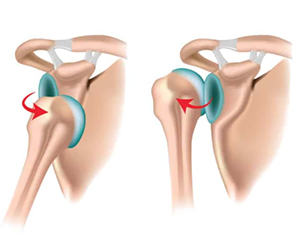What is a Dislocated Shoulder?
 When a dislocated shoulder occurs it is due to an injury where your upper arm pops out of the socket. And this socket is cup-shaped and is apart of your shoulder blade. Since the shoulder is the most mobile joint, it is more susceptible to dislocate.
When a dislocated shoulder occurs it is due to an injury where your upper arm pops out of the socket. And this socket is cup-shaped and is apart of your shoulder blade. Since the shoulder is the most mobile joint, it is more susceptible to dislocate.
It’s important if a shoulder dislocation is suspected to seek immediate medical help. It’s typical for many to regain full shoulder function within 3 weeks. However, like many dislocations, once you have a dislocated shoulder, your shoulder will be more prone to re-occurrences. And this is because your joint will then be unstable.
What Causes a Dislocated Shoulder?
Although dislocations are common, a shoulder dislocation is the most common dislocated joint in the body. Your shoulder moves in many different directions, it can dislocate downward, forward, or backward. Or, it can also dislocate partially or completely. However, most dislocated shoulders occur to the front of the shoulder.
For a shoulder to dislocate, it takes strong force or a hard blow. Dislocated shoulders are often caused by injuries, such as:
- Sports injuries. Shoulder dislocation is a common injury in contact sports, such as football and hockey, and in sports that may involve falls, such as downhill skiing, gymnastics, and volleyball.
- Falls. You may dislocate your shoulder during a fall, such as from a ladder or from tripping on a loose rug.
- Trauma not related to sports. A hard blow to your shoulder during a motor vehicle accident is a common source of dislocation.
Shoulder Dislocation Symptoms
There are a few tell signs of a dislocated shoulder, such as:
- A visibly deformed or out-of-place shoulder
- Swelling or bruising
- Inability to move the joint
- Intense pain
Sometimes, shoulder dislocations will also cause numbness, weakness, or tingling.
Treatment for a Dislocated Shoulder
Non-severe dislocations will be first treated conservatively. These methods include the following:
- Immobilization. Your doctor may use a special splint or sling for a few days to three weeks to keep your shoulder from moving. How long you wear the splint or sling depends on the nature of your shoulder dislocation and how soon the splint is applied after your dislocation.
- Medication. Your doctor might prescribe a pain reliever or a muscle relaxant to keep you comfortable while your shoulder heals.
- Rehabilitation. After your shoulder splint or sling is removed, you’ll begin a gradual rehabilitation program designed to restore range of motion, strength, and stability to your shoulder joint.
However, if this does not help or if your shoulder dislocation is more severe other methods may be necessary, such as:
- Closed reduction. Your doctor may try some gentle maneuvers to help your shoulder bones back into their proper positions. Depending on the amount of pain and swelling, you may need a muscle relaxant or sedative or, rarely, a general anesthetic before manipulation of your shoulder bones. When your shoulder bones are back in place, severe pain should improve almost immediately.
- Surgery. You may need surgery if you have a weak shoulder joint or ligaments and tend to have recurring shoulder dislocations despite proper strengthening and rehabilitation. In rare cases, you may need surgery if your nerves or blood vessels are damaged.
If you are experiencing a dislocated shoulder, call us today at 888-409-8006 to visit a shoulder specialist. Offices conveniently located in South Florida; Boca Raton, Deerfield Beach & Plantation.
OUR DOCTORS
Knee Specialists
Our teams of qualified and skilled physicians provide a personalized experience in a caring and comfortable environment to enhance the quality of life of our patients. Utilizing the latest medical technologies and treatments, our staff are committed to delivering convenient and valuable services to meet the needs of the community.
